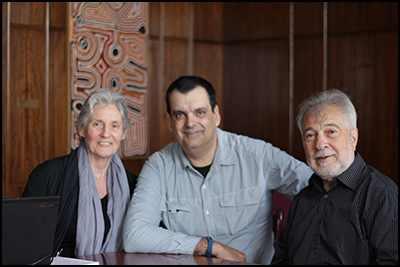 It’s BASH weekend, and picking up on the Canyengue workshop being presented there, the theme for the next two weeks is … Canyengue. This week, a look at the dance and its evolution, followed by the second part of the interview with Nestor Vaz. That’s Tango Capital, 7:00pm to 8:00pm this Sunday
It’s BASH weekend, and picking up on the Canyengue workshop being presented there, the theme for the next two weeks is … Canyengue. This week, a look at the dance and its evolution, followed by the second part of the interview with Nestor Vaz. That’s Tango Capital, 7:00pm to 8:00pm this Sunday
- broadcasting on 2xxfm 98.3 in Canberra
- streaming to the web at http://www.2xxfm.org.au/listen
Image: Ann Smith with Pablo (translating) and Nestor Vaz, immediately after Nestor’s first recital in Australia, with Emily-Rose Sarkova at the Great Hall of Australian National University.
PLAYLIST:
- Cambalache, meaning ‘Exchange, Mix-up, Mess’, a canyengue recorded by Francisco Canaro, on 20 March 1935, with music composed by Enrique Santos Discépolo in 1934, with lyrics by Enrique Santos Discépolo, and sung by Roberto Maida.
- Pato, meaning ‘Duck’, a canyengue recorded by Orquesta Típica Victor, on 20 July 1926, with music composed by Ramón Collazo, with lyrics by Ramón Collazo.
- Pampa, meaning ‘a reference to the treeless plains of Argentina’, a canyengue recorded by Francisco Canaro, on 24 March 1938, with music composed by Francisco Pracánico.
- Mano a Mano, meaning ‘Hand by Hand’, a canyengue recorded by Francisco Lomuto, on 11 August 1944, with music composed by Carlos Gardel & José Razzano in 1923, with lyrics by Celedonio Flores, and sung by Albero Rivera.
- Derecho Viejo, meaning ‘Old Law’, a canyengue recorded by Guardia Vieja in 2005, with music composed by Eduardo Arolas in 1917?.
- Hotel Victoria, meaning ‘Hotel Victoria’, a canyengue recorded by La Tubatango in 2006, with music composed by Feliciano Latasa in 1906, with lyrics by Carlos Pesce.
- Comme Il Faut, meaning ‘Properly (in French)’, a tango recorded by Fernández Fierro in 2001, with music composed by Eduardo Arolas, with lyrics by Gabriele Clausi.
- Qué Miran, meaning ‘What They See’, a concierto recorded by Fernández Fierro in 2014, with music composed by Y. Venturin & Laborde.
- Cafe Hans en Grietje – Serie Amsterdam, meaning ‘Café Hansel & Gretel’, a concierto recorded by Nestor Vaz Quinteto in 2015, with music composed by Nestor Vaz.
- Las Cuarenta, meaning ‘The Fourties’, a canyengue recorded by Francisco Lomuto, on 30 July 1937, with music composed by Roberto Grela in 1936, with lyrics by Francisco Gorrindo, and sung by Jorge Omar.

